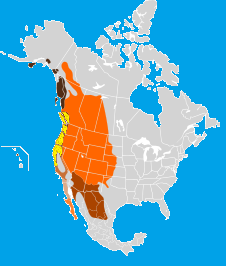
Habitat
 The Columbian black tailed deer (Odocoileus hemiounus columbianus)
can be found in the western coast of the North America, anywhere
from northwestern California all the way up to southwestern Alaska
(Kucera and Mayer 1999). The habitat mainly consists of blossoms,
deer brush, oaks and some open areas with perennial grass (Kucera
and Mayer 1999). This type of habitat is most abundant in the
Klamath National for forest (Kucera and Mayer 1999). This National
Forest is home to about 2 million acres of land that bestrides the
border of California and Oregon (Kucera and Mayer 1999). The
geography of this environment is the foothills of the west coast,
which is usually cool in temperature with vast amounts of rain
(Mihaylo 2009). This environment is provides perfect conditions
compared to the other species in the genus (Mihaylo 2009). The other
species of deer can be found in the surrounding areas but usually
don’t take up the same niche in the environment (Mihaylo 2009). The
black tailed deer can be found on the edge of the forest mostly
because the underbrush and the grasslands are existent, where as you
get deeper this type of landscape diminishes due to the dark forest
(Mihaylo 2009).
The Columbian black tailed deer (Odocoileus hemiounus columbianus)
can be found in the western coast of the North America, anywhere
from northwestern California all the way up to southwestern Alaska
(Kucera and Mayer 1999). The habitat mainly consists of blossoms,
deer brush, oaks and some open areas with perennial grass (Kucera
and Mayer 1999). This type of habitat is most abundant in the
Klamath National for forest (Kucera and Mayer 1999). This National
Forest is home to about 2 million acres of land that bestrides the
border of California and Oregon (Kucera and Mayer 1999). The
geography of this environment is the foothills of the west coast,
which is usually cool in temperature with vast amounts of rain
(Mihaylo 2009). This environment is provides perfect conditions
compared to the other species in the genus (Mihaylo 2009). The other
species of deer can be found in the surrounding areas but usually
don’t take up the same niche in the environment (Mihaylo 2009). The
black tailed deer can be found on the edge of the forest mostly
because the underbrush and the grasslands are existent, where as you
get deeper this type of landscape diminishes due to the dark forest
(Mihaylo 2009).
Most Ideal Habitats
The habitat
that is most likely to be inhabited by the mule deer in general,
this includes the Columbian black tailed deer, is a very highly
dense in shrubs not only to eat but for protection from predators.
As shown by the picture the yellow region is where the Colunmbian
black tailed deer usually is. A study done by The Journal of Wild
Management (2004) shows that the environment doesn’t necessarily
correlate with attacks. In other words the attacks happen weather
the deer are eating or not the mountain lion has a kill percentage
of about 66% (Blecich et al. 2004). Habitat does indeed take a big
part in the deer's reactions and alertness because when it is out in
the open field it is on a much higher alert level then when it is
feeding (Blecich et al. 2004). The Journal of Wild Management (2004)
also stated that the deer seem to feel more comfortable while
feeding because the sense of danger that they have has gone down,
and although they didn’t find enough evidence to determine anything
but it did seem that when the deer are in the bushes the risk level
is less then being out in the open (Blecich et al. 2004).
Another factor that plays a great roll in habitat selection for deer is the presence of Oak (Bower and Kie 2009). It has been shown that deer live near live oak anywhere form 80-70 percent of their lifetimes. This is mostly why the Columbian Black Tailed Deer live in the area that they do because it provides high quality foliage for the deer with of course, limitations to the resource in the winter (Bower and Kie 2009). It was also tested
Refresh your memory on the
Classification
page or continue on and learn about
Adaptations.
Go to
MultipleOrganisms.net.